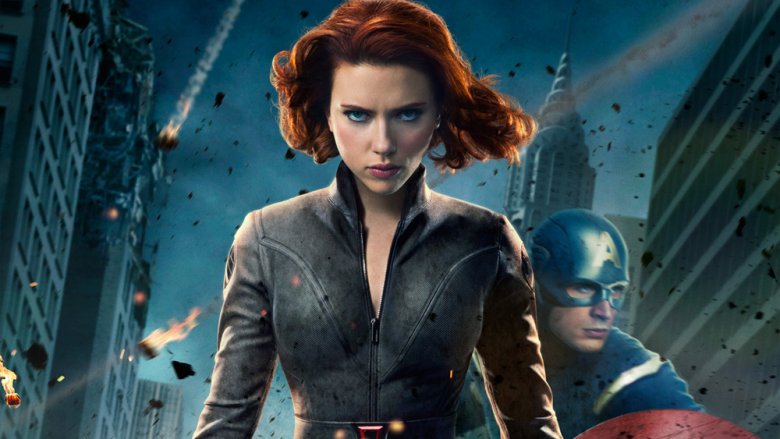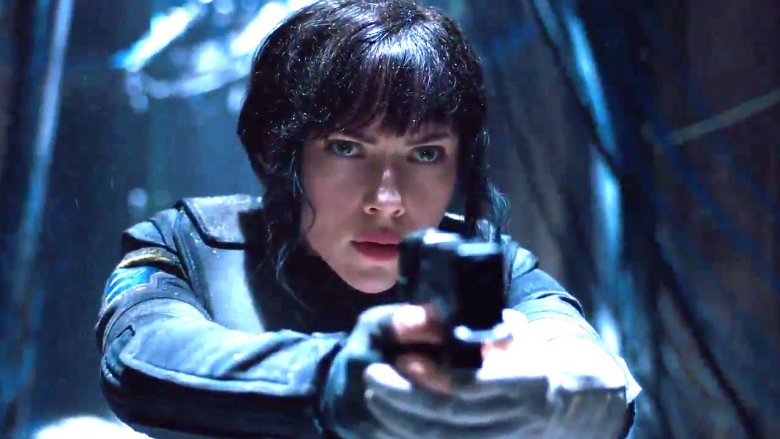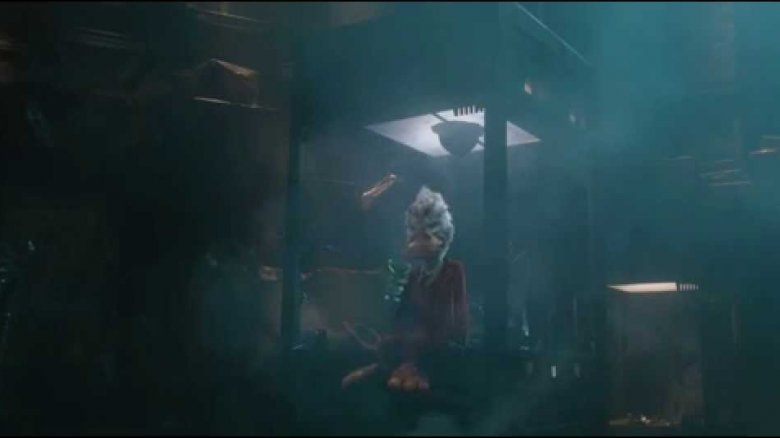Lazy Easter Eggs Everyone Is Tired Of Seeing In Movies
A good movie Easter egg is a wonderful thing. It works as a little shout-out, a special bonus for the high-flying eagle-eyed viewer. In its most perfect form, a solid movie Easter egg makes those who spot it briefly feel excited, special, or just in possession of awesome observation skills, while in no way spoiling the movie experience for those too wrapped up in the action or their popcorn to pick up on it. It's like finding a tiny, colorful treasure in an unexpected place. An "Easter egg," if you will.
Unfortunately, not all movie Easter eggs are vibrant little bundles of goodness filled with deliciously metaphorical chocolate. Some are the cinematic equivalent of reaching for that patterned shell, only to find the inside is full of melted goo and crushed and broken dreams. If you're a filmmaker toying with whether to stick any of these lazy hidden treats into your next blockbuster, maybe it's time to rethink your entire filmmaking strategy. Here are movie Easter eggs we're all a little tired of seeing.
Clues about your 'cinematic universe'
The Marvel Cinematic Universe (MCU) broke all the rules of blockbusters. Suddenly, audiences were willing to pay megabucks not to just see sequels to original flicks, but to see related films featuring characters barely connected to the initial storyline. For non-Marvel producers everywhere, the lesson was clear. Cinematic universes weren't just in, they were so in they practically required a whole new preposition be invented. All you had to do was take a leaf out the Marvel playbook and constantly tease upcoming spin-offs ... ideally by sticking in as many annoying Easter eggs as possible.
The biggest offenders in this category of "derailing the story with meaningless clues about future projects" are films from the DC Extended Universe. Batman v Superman wasn't just a dragging mess of questionable story decisions, it was all that plus a movie that took a huge breather from its own plot to introduce Aquaman, Cyborg, and the Flash with a level of detail that was somehow both simultaneously boring and excruciating.
But, hey, at least those characters later turned up in Justice League. Amazing Spider-Man 2 spent time and energy setting up clues about future extended universe movies like The Sinister Six only for the entire project to get scrapped. And Universal's "Dark Universe" topped out prematurely by having Doctor Jekyll not only turn up in The Mummy, but go full Mr. Hyde, too. Needless to say, that cinematic "universe" wound up featuring only a single film (via the Independent).
Creator or original actor cameos
Awesome as they can be, Marvel sure does have a lot to answer for where endlessly repeated Easter eggs are concerned. Stan Lee's sometimes subtle, sometimes glaringly awful cameos in every single MCU film have gone from being hip, to overdone, to almost hip again thanks to their sheer ubiquity. While it might be a bit much to expect Marvel to ditch his appearances after a decade, especially with Lee being 95 and presumably not expected to make many more cameos, not launching this trope in the first place would have spared us from appearances that required a Hulk-sized shoehorn to lever in.
But creator cameos are at least in short supply outside the MCU. Far more prevalent are cameos from original cast members. At a time when Hollywood is tripping over itself to reboot, recharge, and recast anything that smacks of success (we've had three Spider-Men in barely a decade), movies are also trying to pack themselves full of retro nostalgia. So you might get a completely new, all-female Ghostbusters, but you'll also get mandated appearances by members of the original cast. Or maybe you'll get a parallel universe Star Trek film series, but one in which original Spock is there because ... ? Or maybe a Power Rangers reboot where the old pink and green rangers appear and ... y'know what? Let's just accept that original cast cameos are overdone by this point.
Needless callback lines
Did you know the actor Arnold Schwarzenegger once appeared in a movie called The Terminator, and that he said the line "I'll be back"? If you're hoping to watch any Arnie movie, past, present, or future, be prepared for that line return to you again and again, like some out-of-control boomerang. Arnold says "I'll be back" or some variation of it in almost every post-Terminator movie he's been in, including the lesser-seen whimsical 2007 comedy Mr. Schwarzenegger Goes to the California Governor's House (via New York Times). By the time it resurfaced in The Expendables III, the line was as old and tired as the Expendables themselves.
Arnie might have been an early adopter of the needless callback Easter egg, but he certainly wasn't the last. Moving into the modern era, we're in danger of getting swamped beneath a tidal wave of half-remembered quotes that, just like marriages, go from "awesome" to "depressing" the more times you experience them.
The chief offenders in the court of unnecessary callbacks might well be the new Star Wars movies. As Slate exhaustively detailed, much of the dialogue in The Force Awakens amounts to "insert classic Star Wars reference here." The Last Jedi was a little more restrained, but characters still had bad feelings about this, and other callbacks (via Den of Geek). Hey, it's easier than having to write a whole new script from scratch.
Endless post-credits scenes
If you saw 2017's excellent elegy to the most iconic screen superhero of all, Logan, you may have noticed the lack of a post-credits sequence. There's a good reason for that. Director James Mangold hates post-credits sequences. Like, really hates them, to the point that he once went on an epic, six-tweet rant against them, which converts to 12 tweets in the old times (via IndieWire). He called them the crack cocaine of cinema, designed to give audiences a quick high and ensure that their hard-earned dollars flowed from their pockets and into producers' swags.
Mangold's beef with post-credits scenes goes pretty deep. He fears they turn legitimate works of art into nothing but money-spinning machines devoid of soul. Before anybody cracks wise about superhero films not being art, let's reiterate again that this is the guy who directed Logan, to date the only modern superhero film to get an Oscar nomination for story rather than effects or cinematography (via Vulture). His position is that all superhero movies have it in them to be Logan.
Even disregarding Mangold's opinion, there's still plenty to dislike about post-credits sequences. When most superhero films now feel they have to have at least two (see Black Panther, Justice League) and some feel the need to have five (lookin' at you, Guardians of the Galaxy 2) the concept has probably jumped the shark.
Intriguing hints of backstory (that never go anywhere)
It may be hard to believe now, but in 2016 the movie with the biggest pre-release buzz was Batman v Superman. One of the most dissected parts of the early trailers was a sneak peek of Ben Affleck's Bruce Wayne looking sad about an old Robin costume painted with the words "Ha ha ha, joke's on you Batman." The internet went nuts. Was the Joker going to be in Batman v Superman? Would Suicide Squad include a flashback scene where we saw Jason Todd bite the dust? At last, the two movies came out and ... nothing. The promised backstory went nowhere.
Not every movie needs to explain a character's past. But there's leaving certain things unsaid, and then there's baiting everyone that this is gonna be a massive, major part in your massive, major franchise, and then quietly shelving it without explanation. Star Wars: The Force Awakens spent ages setting up the mystery of Rey's parents, encouraging fans to debate it online for two years, only for The Last Jedi to effectively say "nah, we just wanted to mess with you. Psych!" The Avengers teed up a major Hawkeye/Black Widow connection involving a mission to Budapest, only for the MCU to get bored and wander away from the idea before we could learn anything interesting. (As Screen Rant has shown, Marvel is kinda bad for this.) Nor is it only movies. TV show Doctor Who has been abandoning plot threads with gusto since 2005.
Reusing already overused Easter eggs
You've almost certainly heard a Wilhelm scream at some point. A quick, cheesy death cry, it was first used as a sound effect in the 1951 film Distant Drums, in a scene where a guy gets eaten by an alligator. After being rediscovered in a sound effects library in the mid-1970s by a technician named Ben Burtt, it found its way into Star Wars: A New Hope, in a scene where a stormtrooper plunges off a balcony. His death wail was so distinctive that other sound technicians started to use it in homage to George Lucas. It appeared in the Indiana Jones series, Poltergeist, Batman Returns, Aladdin, Beauty and the Beast, Reservoir Dogs, Lord of the Rings, and The Fifth Element.
As a result, the Wilhelm scream has appeared in over 300 movies (via Priceonomics blog). It's so overused that hearing it no longer elicits a nod of recognition so much as a Wilhelm scream itself.
The Wilhelm scream is a particularly bad offender, but there are other movie in-jokes that keep getting stuck in way beyond the point that doing so was original or anything but a kind of sad duty. References to George Lucas' movie THX 1138, usually in the form of the numbers only, abound in pop culture. One quixotic attempt by an IMDB user to list them all found 100-ish films in which they appear, which is roughly 99 more films than is necessary.
Easter eggs unrelated to anything in your movie
Plenty of filmmakers stick shout-outs to other films in their work, either because they're rivals of the other director (see Sam Raimi and Wes Craven's decades-long referencing of each other's movies), or because they were inspired by them (see every single Kubrick reference ever made). That's all part of the fun of watching movies. Who could object to Evil Dead references in Nightmare on Elm Street, or nods to 2001: A Space Odyssey in Sunshine? Nah, this particular little Easter egg only gets weird when it crops up in ill-suited movies. Like the time the director of Coco stuffed his family animation with references to The Shining (via Syfy).
The Shining is an influential film, and a popular one. It might be understandable that Coco director Lee Unkrich is obsessed with it. But it feels a little like overkill to put three separate shout-outs into a film aimed at a much younger market than Kubrick's legendary frightfest.
Modern family films seem to have an endless need for references to keep Mom and Dad engaged. Pixar has been doing this since Toy Story, and while they've featured many great little shout-outs, some, like the Total Recall and Scarface references, seem pretty pointless. With less talented filmmakers copying them, family films can now feel like extended Family Guy skits. It's kinda like everything else The Simpsons did first: awesome in the '90s, done to death now.
Quick scenes explaining away major controversies
The mid-2010s featured a whole lotta people flipping out over pop culture. 2016's Ghostbusters was the epitome of this, drawing a molten river of anger because of its female cast. But others received a lesser drubbing, such as the Captain America series over its supposed queerbaiting (suggesting a romantic link between two male or two female characters but not following through). This led to a very particular kind of Easter egg: the quick scene trying to explain away major controversies.
The pinnacle of this was the live-action remake of Ghost in the Shell. When Scarlett Johansson was cast in the role of cyborg backside-kicker Major, some said this amounted to whitewashing. While Major's ethnicity was never revealed in the original anime (indeed, the director told The Guardian she could have been seen as white), her name was Motoko Kusanagi, implying Japanese heritage. When the backlash erupted, the producers neither recast Johansson nor decided to just keep their heads down and ignore it. Instead — spoiler — they stuck in a quick twist scene where Major was revealed to be a Japanese woman whose brain had been implanted in a white cyborg body (via Slate).
This was probably the worst route to go down, as it meant everyone wound up offended, but it also set a dangerous precedent for movies blithely trying to address their own controversies with simple Easter eggs.
Teasing future characters or plots (that never go anywhere)
One of the great things about adapting comics for the screen is the sheer wealth of stories you have to draw on. Most of the big superhero movies of the last decade — from The Dark Knight to Captain America: Civil War — took their cues from graphic novels. A side effect is that you've got a legion of die-hard fans who are super excited to see clues cropping up about their favorite characters. It's only when you tease these things then fail to follow through that this excitement turns into exasperation.
Sometimes, these teases aren't too big a deal. The end of Guardians of the Galaxy teed up Howard the Duck, who has since only re-appeared in a single scene. Still, memories of how terrible 1986's solo Howard the Duck movie was probably took the edge off this one. Other times, the teases are laced with the bitter cyanide of disappointment.
Avengers: Age of Ultron contained an Easter egg that seemed to promise big changes. The name of female robot Jocasta is briefly seen in Stark's lab, a huge deal as she later becomes an Avenger. To date, that hint has gone absolutely nowhere, just like the Essex Corp. reference in X-Men: Apocalypse that teased Mister Sinister for Logan. (Spoiler: He didn't appear.) But the most annoying of these may have come way back in 1989's Batman. After briefly introducing Billy Dee Williams as Harvey Dent — aka Two Face — Burton dropped him from the sequel.
Awful cameos of beloved characters
A quick heads-up. This is gonna be pretty X-Person heavy, as the X-Men franchise is where producers try their hardest to shoehorn in beloved characters in a way that totally ruins them. Intended as a bit of harmless fanservice, these tiny cameos usually wind up defecating all over what fans loved about these characters in the first place.
The absolute worst version of this was Deadpool's first onscreen appearance in X-Men Origins: Wolverine, in which Ryan Reynolds' Wade Wilson becomes the "Merc with a mouth," only to have his face-hole fused shut. Still, at least Reynolds got to completely retcon the character for Deadpool. As CBR notes, others weren't so lucky. In X-Men: Last Stand, Glob Herman got two seconds of screentime, in which he permanently lost his mutant powers. Henry Gyrich was killed offscreen in the first X-Men. Kid Omega didn't even have the right powers. Still, at least it occasionally happens the other way around. In the comics Negasonic Teenage Warhead exists for about five panels, while Deadpool turned her into a proper, hilarious character.
Sadly, this unintentionally sucky Easter egg doesn't just afflict X-Men films. Attack of the Clones took badass intergalactic bounty hunter Boba Fett and made him into a traumatized kid. The 2016 Ghostbusters very nearly stuck in an origin story for Slimer, and, as Wired details, it would have been as pointless and as awful as you're imagining. Darn it, Hollywood, can't you get anything right?


